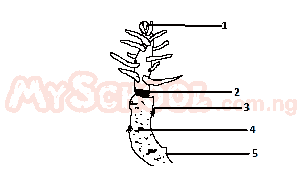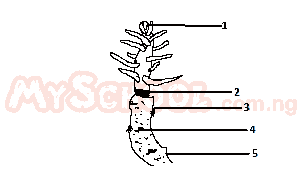Year :
1990
Title :
Biology
Exam :
JAMB Exam
Paper 1 | Objectives
1 - 10 of 50 Questions
| # | Question | Ans |
|---|---|---|
| 1. |
Viruses are considered to be living organisms because they A. possess transmittable characters B. move from one place to another C. respond to stimulation D. ingest food materials |
A |
| 2. |
Which of the following characteristics is common to Amoeba and Paramecium? A. Oral groove B. Trichocyst C. Contractile vacuole D. Cilia |
C |
| 3. |
Hydra removes undigested food by A. passing it through the anus B. passing it through the mouth C. means of a contractile vacuole D. egesting it through the body surface |
B |
| 4. |
Which of the following groups of invertebrates reproduces by budding? A. Arthropoda B. Annelides C. Mollusces D. Coelenterata |
D |
| 5. |
The algae, bryophytes and pteridophytes are similar in that they A. are sea weeds B. have no vascular tissue C. require moisture for fertilization D. are microscopic plants Detailed SolutionAlgaes, bryophytes and pteridophytes require water for their flagellated sperm to swim through to reach the egg. |
|
| 6. |
The spores of ferns are dispersed by A. wind B. water C. insects D. explosive mechanism E. sporophyte |
D |
| 7. |
 The part labelled 3 is the A. leaf scar B. lenticle C. auxillary bud D. girdle scar |
C |
| 8. |
 Which part of the twig produces auxins? A. 4 B. 3 C. 2 D. 1 |
D |
| 9. |
Which of the following animals has homodont dentition? A. Rat B. Man C. Lizard D. Pigeon |
C |
| 10. |
In which of the following does external fertilization takes place? A. Toad B. Lizard C. Bird D. Cockcroach |
A |
| 1. |
Viruses are considered to be living organisms because they A. possess transmittable characters B. move from one place to another C. respond to stimulation D. ingest food materials |
A |
| 2. |
Which of the following characteristics is common to Amoeba and Paramecium? A. Oral groove B. Trichocyst C. Contractile vacuole D. Cilia |
C |
| 3. |
Hydra removes undigested food by A. passing it through the anus B. passing it through the mouth C. means of a contractile vacuole D. egesting it through the body surface |
B |
| 4. |
Which of the following groups of invertebrates reproduces by budding? A. Arthropoda B. Annelides C. Mollusces D. Coelenterata |
D |
| 5. |
The algae, bryophytes and pteridophytes are similar in that they A. are sea weeds B. have no vascular tissue C. require moisture for fertilization D. are microscopic plants Detailed SolutionAlgaes, bryophytes and pteridophytes require water for their flagellated sperm to swim through to reach the egg. |
| 6. |
The spores of ferns are dispersed by A. wind B. water C. insects D. explosive mechanism E. sporophyte |
D |
| 7. |
 The part labelled 3 is the A. leaf scar B. lenticle C. auxillary bud D. girdle scar |
C |
| 8. |
 Which part of the twig produces auxins? A. 4 B. 3 C. 2 D. 1 |
D |
| 9. |
Which of the following animals has homodont dentition? A. Rat B. Man C. Lizard D. Pigeon |
C |
| 10. |
In which of the following does external fertilization takes place? A. Toad B. Lizard C. Bird D. Cockcroach |
A |